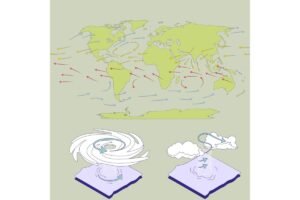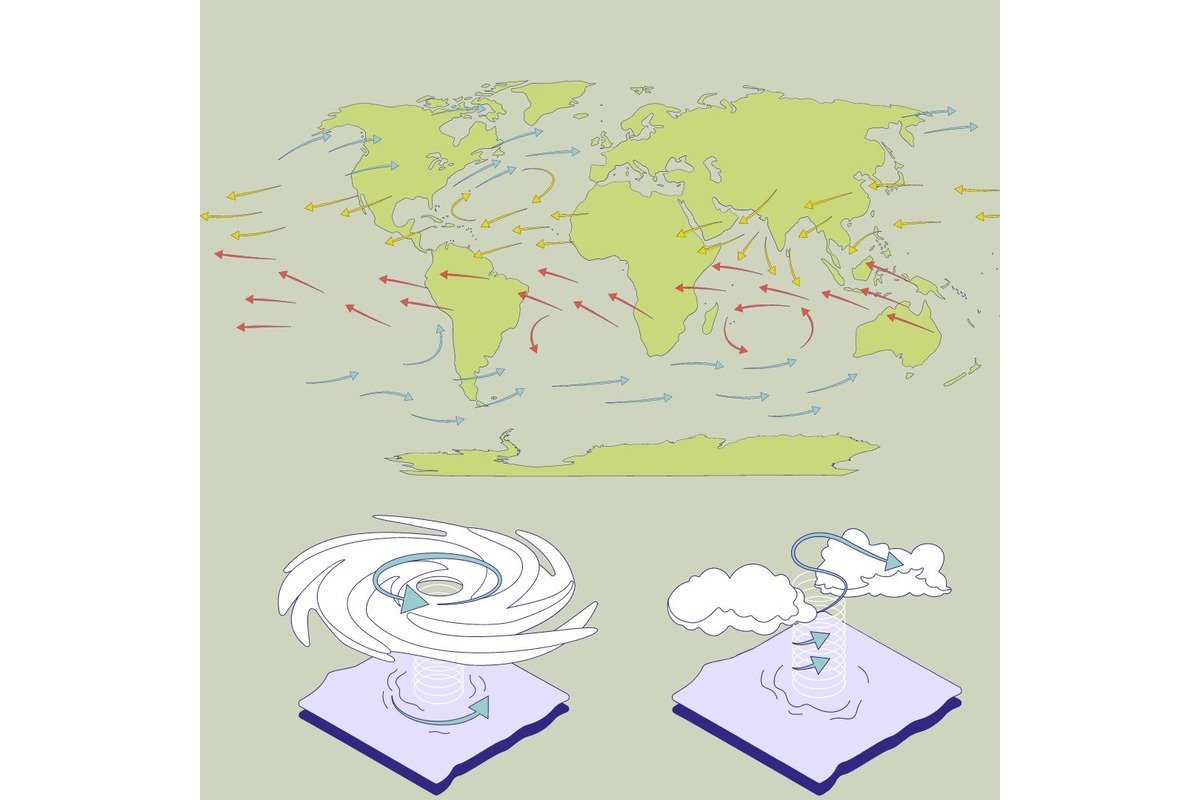Introduction to Local Winds
Local winds refer to atmospheric movements that occur over relatively small geographical areas, typically spanning tens to hundreds of kilometers. Unlike global wind patterns driven by the Earth’s rotation and atmospheric circulation, local winds are primarily influenced by localized factors such as topography, temperature differentials, and pressure gradients. While they may not attract the same level of attention as hurricanes or monsoons, local winds play a vital role in regulating temperatures, distributing moisture, and shaping weather conditions at the regional level.
Formation Mechanisms
The formation of local winds is governed by various factors, including differential heating and cooling, terrain features, and pressure differentials. In coastal areas, temperature disparities between land and water surfaces drive the development of sea and land breezes, while mountain and valley breezes result from variations in surface heating across rugged landscapes.
Additionally, the presence of natural barriers such as mountains or hills can influence wind patterns by deflecting or channeling airflow. Pressure gradients, created by differences in air density and temperature, also play a crucial role in initiating and sustaining local wind phenomena.
Characteristics of Local Winds
Local winds exhibit a wide range of characteristics, including variability in speed, direction, and seasonal patterns. While some local winds, such as sea breezes, are relatively gentle and predictable, others, like mountain winds, can be intense and erratic, posing challenges to navigation and outdoor activities. Seasonal variations in temperature and atmospheric conditions further contribute to the dynamic nature of local wind systems, with certain winds becoming more prominent during specific times of the year.
Historical Significance

Throughout history, local winds have played a significant role in shaping human societies, economies, and cultures. In regions where wind patterns influence agricultural practices and trade routes, local winds have been integral to the development of civilizations. Sailors and navigators have long relied on prevailing winds for maritime exploration and trade, with historical accounts documenting the strategic importance of wind patterns in shaping naval battles and conquests.
Types of Local Winds
Several types of local winds are observed across different geographical regions, each exhibiting distinct characteristics and formation mechanisms.
- Land and Sea Breezes: Land and sea breezes are common coastal phenomena driven by differential heating between land and water surfaces. During the day, the land heats up more quickly than the adjacent sea, creating a low-pressure area over the land. Cooler air from the sea then flows inland to replace the rising warm air, resulting in a sea breeze. At night, the process reverses as the land cools faster than the sea, leading to the development of a land breeze.
- Mountain and Valley Breezes: In mountainous regions, mountain and valley breezes occur due to temperature differences between slopes and valleys. During the day, the sun heats the slopes of mountains, causing the air to rise and creating a valley breeze as cooler air from the valley flows uphill. At night, the slopes cool rapidly, and the denser, cooler air descends into the valleys, creating a mountain breeze.
- Katabatic and Anabatic Winds: Katabatic winds, also known as downslope winds, occur when cold, dense air descends under the influence of gravity. These winds are common in mountainous regions where air cools rapidly at higher elevations, becoming denser and heavier, and then flows downhill. Anabatic winds, on the other hand, are upslope winds driven by the heating of the Earth’s surface. As the sun warms the ground, the air above it rises and flows upslope, typically observed during the daytime in areas with steep terrain.
- Whirlwinds: Whirlwinds are rapidly rotating columns of air that are often associated with thunderstorms or tornadoes. These intense vortices can vary in size and strength, ranging from small dust devils to large tornadoes capable of causing significant damage. Whirlwinds typically form under conditions of strong atmospheric instability and vertical wind shear, where rising warm air interacts with cooler air aloft.
- Foehn/Chinook Winds: Foehn winds, also known as chinook winds in North America, are warm, dry downslope winds that occur on the lee side of mountain ranges. As moist air ascends the windward side of the mountains, it cools and releases moisture, creating precipitation. The dry air then descends the leeward side, warming adiabatically due to compression, and resulting in warm, gusty foehn winds.
- The Berg & Bora Winds: The berg wind, prevalent in South Africa, is a hot, dry wind that originates from the interior high plateau and flows towards the coast. It is characterized by its high temperatures and low humidity, posing risks of heatwaves and wildfires in affected areas. The bora wind, on the other hand, is a cold, gusty wind that originates from high-pressure systems over continental Europe and flows down the lee side of the Dinaric Alps towards the Adriatic Sea. It can reach high speeds and is associated with clear, dry conditions.
- The Mistral Winds: The mistral is a strong, cold, northwesterly wind that originates in the Alps and flows towards the Mediterranean coast of France. It is most common during the winter months and can reach speeds of up to 100 kilometers per hour. The mistral is known for its cleansing effect on the atmosphere and its influence on local weather patterns, often bringing clear skies and cooler temperatures to the region.
- The Simoon & Sirocco Winds: The simoon, also known as the samum, is a hot, dry, dust-laden wind that occurs in desert regions, particularly in North Africa and the Arabian Peninsula. It is associated with intense heatwaves and sandstorms, posing health risks to humans and animals exposed to its extreme conditions. The sirocco, on the other hand, is a hot, humid wind that originates in the Sahara Desert and blows northward across the Mediterranean Sea, affecting countries in southern Europe and North Africa. It can bring dusty air and high temperatures to affected regions.
- Miscellaneous Local Winds: Beyond the aforementioned types, there are numerous other local winds observed in different parts of the world, each with its own unique characteristics and influences. Examples include the zonda winds in the Andes Mountains of South America, the nor’westers in New Zealand, and the föhn winds in the European Alps. These winds play important roles in shaping local climates, ecosystems, and cultural practices in their respective regions.
Conclusion
In conclusion, local winds represent a fascinating yet often overlooked aspect of Earth’s atmospheric dynamics, exerting profound influences on regional climates, ecosystems, and human activities. From shaping weather patterns to driving renewable energy production, local winds play a multifaceted role in our daily lives and collective future. By deepening our understanding of the mechanisms driving local wind phenomena and adopting proactive mitigation and adaptation strategies, we can harness the power of nature’s whisper to build a more resilient and sustainable world.
Frequently Asked Questions (FAQs)
- Are local winds the same as global wind patterns?
- While both local and global winds involve the movement of air masses, they differ in scale, duration, and driving mechanisms. Local winds are confined to specific geographical areas and are influenced by localized factors such as topography and temperature differentials, whereas global wind patterns are driven by the Earth’s rotation and atmospheric circulation on a planetary scale.
- How do local winds impact weather and climate?
- Local winds can influence weather conditions by redistributing heat and moisture within a region, moderating temperatures, and affecting cloud formation and precipitation patterns. Their interactions with larger-scale atmospheric systems contribute to the complexity of weather and climate dynamics at both regional and global scales.
- What are some examples of safety precautions for dealing with local winds?
- Safety precautions for local winds vary depending on the specific wind phenomenon and geographical context. However, general recommendations include staying informed about weather forecasts and advisories, securing outdoor objects that could become projectiles in strong winds, and avoiding outdoor activities in hazardous conditions.
- How do local winds impact agriculture and farming practices?
- Local winds can influence agriculture in various ways, including moderating temperatures, distributing pollen and seeds, and affecting irrigation needs. Farmers may use knowledge of prevailing wind patterns to select crop varieties, plan planting schedules, and implement windbreaks or other protective measures to minimize wind-related damage to crops and soil.
- What role do local winds play in renewable energy generation?
- Local winds provide a renewable energy resource that can be harnessed through wind turbine technology to generate electricity. By strategically locating wind farms in areas with consistent local wind patterns, renewable energy developers can contribute to reducing greenhouse gas emissions and transitioning towards a more sustainable energy future.






One thought on “Local Winds”